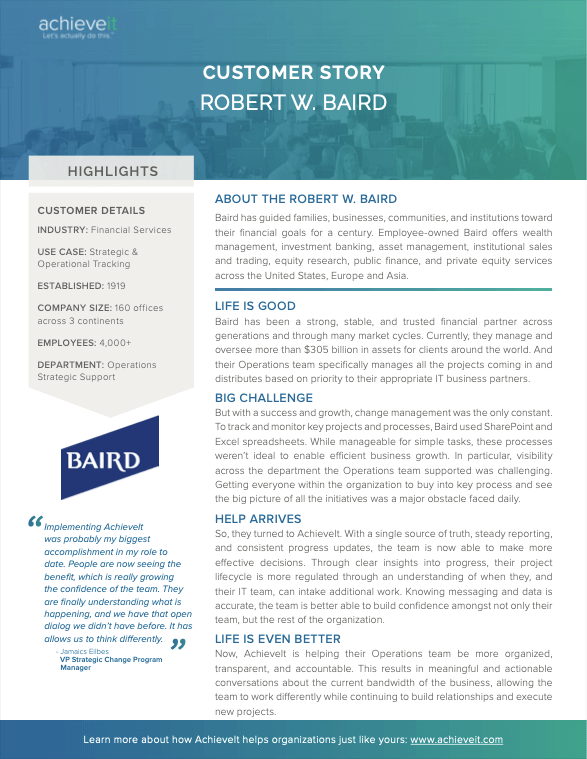Before the pandemic, only 8% of workers worked remotely. This skyrocketed to 70% in Q2 of 2020. And according to the latest statistics, 26% of the U.S. workforce is still working remotely, while 53% have hybrid working arrangements.
So what does this mean for distributed strategy teams, especially without a virtual alternative to spending a day in the boardroom hashing things out? The answer is hybrid work and the right tools that allow for visibility and collaboration.
According to Joe Krause, VP of Customer Engagement at AchieveIt, the large majority of planning work can be done remotely, but face-to-face interaction is still crucial for success. Beyond that, having the right planning tools at your disposal can help distributed teams remain cohesive and effective.
Strategy translators’ and doers’ jobs have gotten trickier
The remote or hybrid experience is different depending on which role you occupy in your planning team — architect, translator, or doer.
Architects make high-level decisions
Architects identify the focus areas for the organization. They receive a lot of requests and correspondence from people across the organization, from board members to internal and external stakeholders.
An organization generally has just a few architects — usually around three or four. The size of this group means they can carry out most of their work virtually. They can easily coordinate among themselves over Zoom calls.
FREE RESOURCE
Leading from the Center
Download this guide to understand how to optimize power and influence to accomplish your most important initiatives.

Translators create plans and measure success
Translators occupy the key role of translating the ideas to the rest of the organization. And they often hold positions like chief strategy officer (CSO) or director of strategy. They take the visions of the architects and turn them into plans, KPIs, initiatives, and projects. Translators usually manage and collaborate with a large number of people, which becomes trickier in a distributed environment.
Before, translators would have been able to organize large in-person meetings and workshops to get planning underway. In a distributed or remote setup, they’re spending more time organizing and hosting a number of smaller meetings that are more manageable over video calls.
Doers execute the plan
Doers report to the translators and are responsible for executing specific tasks linked to the overall strategy. Even in an on-site setting, doers may find it tricky to focus on the big picture of what they’re working toward. This becomes even more difficult in a remote environment. Remote doers can easily lose the connection between their work and the overall planning process.
In such situations, doers may neglect repetitive tasks like filling out status updates in a timely manner because they fail to see the importance of doing so.
Hybrid setups are ideal for strategic planning and execution
An important ingredient for successful strategic planning and execution is getting people together. So remote work may get the job done for a lot of the day-to-day work, but strategy teams need to physically come together from time to time.
If you’re a translator, bring your team together at the start of the process for one big meeting. Present the plan, assign roles and tasks, and send people on their way with clear instructions. After that, hold occasional in-person check-ins to ensure everyone is on the same page.
Technically speaking, Joe says, these meetings can be held virtually, but they’re just not as effective. “Strategic planning is getting the best ideas from your people. This is formulated when they’re staring at each other. If I ask a group of people to spend seven hours with me in a conference room with lunch, they’ll be happy to do it. If I said we were going to have a Zoom meeting for seven hours? No way.”
Virtually, one big meeting becomes several smaller meetings with different teams. You lose context and excitement — not to mention time. People lose attention quickly as video call fatigue kicks in. Without everyone in the same place, it also becomes much trickier to make decisions since stakeholders are not discussing and voting at the same time.
Visibility, accountability, and collaboration are more important than ever
Whether remote, hybrid, or on-site, many strategy teams struggle with siloed information. This is particularly true if they use manual processes like spreadsheets and word processors to carry out their work.
In the early planning stages, information is centralized, but as the plan is implemented by different teams, the process gets more complicated. One team sets up a spreadsheet, another a Word document, and another a PowerPoint presentation. Things get really tricky when it’s time to gather all of that information for an upcoming status update.
“All of a sudden, instead of one version of the truth, you have 10, 15, 20 different versions of it. As a translator, you’ve got to put it all back together, which is a nightmare,” says Joe.
To avoid this problem, use purpose-built, integrated plan management systems. These systems maintain one centralized version of the truth across the entire organization. If anyone wants to know where a specific plan item is or what its latest status is, they just consult their tool.
Using these tools avoids siloes and presents information across all teams in one format. This helps with planning governance across the organization, including setting rules and norms on status updates, such as frequency and format.
With team members working across different locations and time zones, it’s even more difficult to know who to reach out to if you need an update on an item. And collaboration is a nightmare.
Integrated plan management platforms solve these challenges. Initiatives are assigned to specific individuals, making it clear and visible who is responsible for what. This visibility and the availability of a singular version of the truth means teams understand what everyone else is doing. Collaboration is easier and more effective.
FREE RESOURCE
Robert W. Baird Customer Story
Read this customer story to better understand how a financial institution gained accountability and transparency on their projects with AchieveIt.

Baird created more organized, transparent, and accountable processes with AchieveIt
Multinational investment firm and financial services company Baird was using manual processes like SharePoint and Excel spreadsheets to track and monitor key projects and processes. These ultimately proved obstacles to efficient growth. Visibility was poor, and the organization lacked buy-in across the board.
Baird turned to AchieveIt to help manage their processes. With a single source of truth, steady reporting, and consistent progress updates, the team made more effective decisions. Baird’s operations team is more organized, transparent, and accountable, empowering them to build more relationships and execute new projects.
To learn more about Baird’s path to success with AchieveIt, read the full customer story here.



